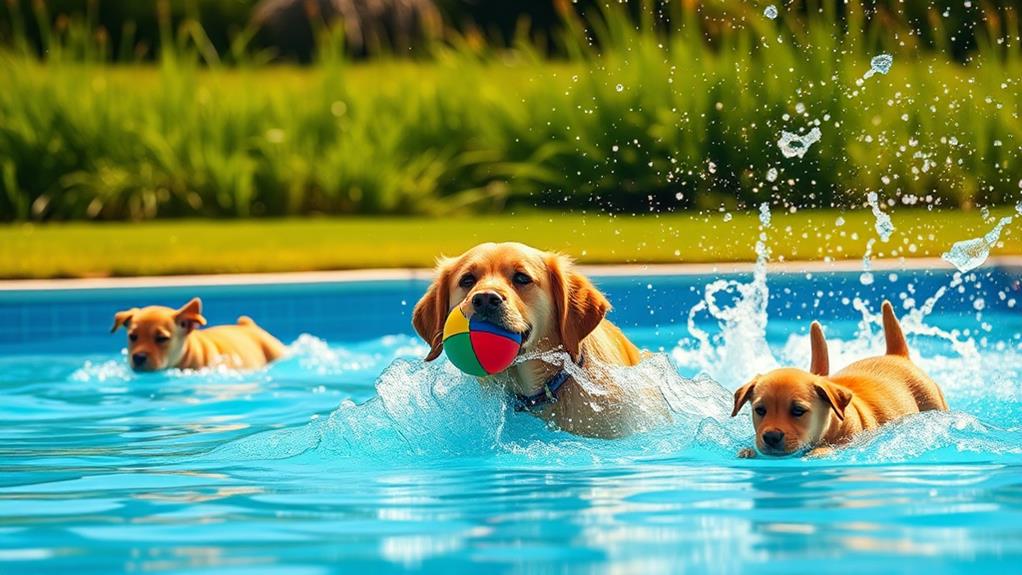Swimming's a fantastic way to boost your dog's fitness, combining fun and exercise. Start with "fetch in water" for physical and mental stimulation. Then try "water retrieve" to enhance swimming skills and workout intensity. Organize "doggy paddle races" for friendly competition that builds endurance and speed. Don't forget about introducing your dog to new toys and varying activities to keep them engaged. Always guarantee safety by supervising and familiarizing them with the water. With these exercises, your canine will not only stay fit but also enjoy the experience. Keep going to discover even more ways to keep your pup active!
Importance of Swimming for Dogs
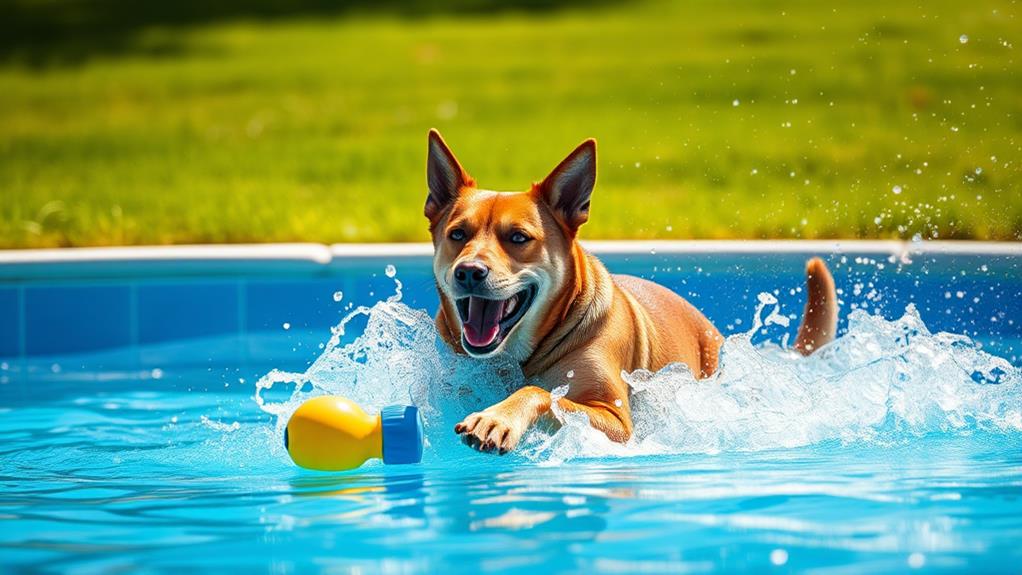
Swimming is essential for dogs, as it offers both physical and mental benefits that can enhance their overall well-being. When your dog splashes around in the water, they're engaging in a full-body workout that strengthens muscles and improves cardiovascular health. Unlike running or jumping, swimming is low-impact, making it an excellent choice for dogs with joint issues or those recovering from injuries.
Moreover, swimming helps burn off excess energy, which can reduce behavioral problems like chewing or barking. Your dog's mental stimulation increases as they navigate through the water, explore new environments, and engage with you or other dogs. This activity can also build their confidence, especially if they're initially hesitant about water.
Encouraging your dog to swim can improve their social skills, too, as they interact with other dogs or people at the pool or beach. Plus, it's a fantastic bonding experience for both of you. So, whether you're at a lake, pool, or beach, consider incorporating swimming into your dog's routine. It's a fun way to keep them fit while ensuring they enjoy the great outdoors.
Safety Tips for Swimming
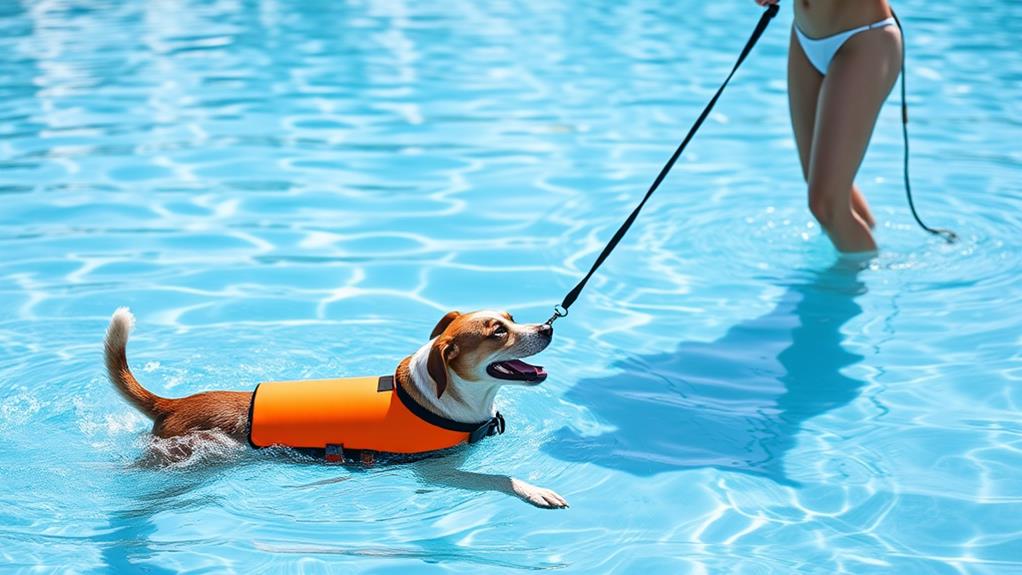
When it comes to dog swimming safety, preparation is key. First, always supervise your dog while they're in the water. Even if they're a great swimmer, accidents can happen.
Familiarize yourself with the swimming area, checking for potential hazards like strong currents, sharp objects, or deep spots.
Next, guarantee your dog's comfort in the water. If it's their first time, introduce them gradually. Use a life jacket designed for dogs, especially if your pet is nervous or not a strong swimmer. This'll provide added buoyancy and help keep them safe.
Make sure your dog knows basic commands like "come" and "stay." These commands can be invaluable if you need to get your dog's attention quickly. Additionally, be mindful of the water temperature. Dogs can overheat or get too cold, so make sure it's a comfortable range for them.
Exercise 1: Fetch in Water
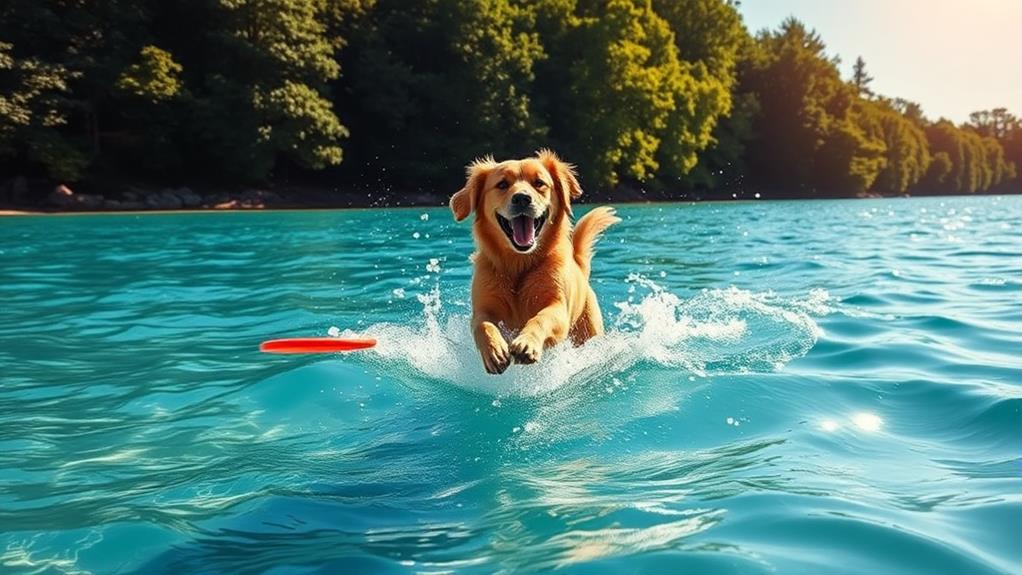
Engaging your dog in a game of fetch in the water is a fantastic way to combine exercise and fun. This activity not only keeps your pup physically active but also mentally stimulated. To get started, find a safe swimming area, like a lake or a pool, where your dog can splash around. Use a floating toy to capture your dog's attention and encourage them to swim after it.
Here's a quick overview of the benefits of this exercise:
| Benefit | Description | Tips to Maximize |
|---|---|---|
| Physical Exercise | Builds strength and endurance | Allow short breaks |
| Mental Stimulation | Keeps your dog engaged | Change up the toys |
| Bonding Time | Enhances your relationship | Play together regularly |
While playing, remember to supervise your dog at all times and provide plenty of fresh water to keep them hydrated. If your dog seems tired, take a break and let them rest. With each toss, you'll see your dog's excitement grow, making fetch in the water an enjoyable and rewarding experience for both of you.
Exercise 2: Water Retrieve
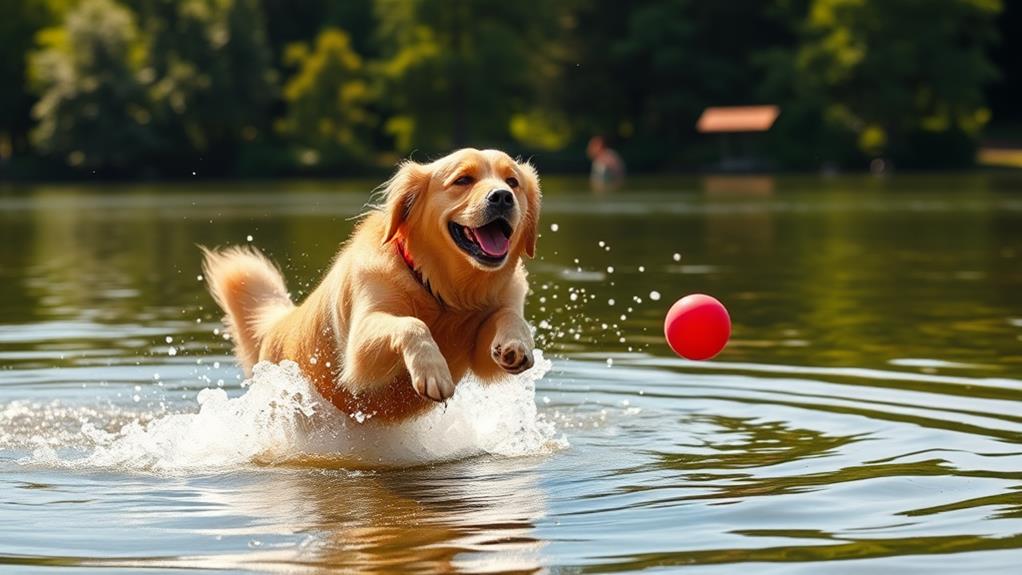
Water retrieve is an excellent way to enhance your dog's swimming skills while also providing a great workout. This exercise encourages your pup to plunge into the water, build endurance, and develop their retrieving instincts.
Start by choosing a safe, shallow area where your dog can easily access the water. You'll want to use a toy or a ball that floats, ensuring it's easy for your dog to spot.
Begin by tossing the toy a short distance into the water. Encourage your dog to swim out and fetch it back. Use positive reinforcement—praise them when they retrieve the toy, and offer treats to create a positive association. If your dog hesitates to jump in, you can gradually increase the distance, allowing them to grow comfortable with the water.
As your dog becomes more confident, challenge them by throwing the toy farther or into deeper water. Always supervise your dog during this exercise, ensuring they're safe and enjoying themselves.
Water retrieve not only enhances swimming skills but also strengthens the bond between you and your dog. It's a fun, engaging way to keep your pup fit and happy!
Exercise 3: Doggy Paddle Races

After your dog masters the water retrieve, you can amp up the fun with doggy paddle races. This exercise not only boosts your dog's swimming skills but also enhances their speed and endurance. To start, find a safe, shallow area in the water where your dog can race without hazards.
Gather a few friends and their dogs for a friendly competition. Line your dogs up at one end of the designated area. Use a toy or a floating object as the finish line. When everyone's ready, give the signal to start! You'll notice your dog's natural instincts kick in as they paddle furiously towards the prize.
Encourage your dog throughout the race and reward them with praise or treats when they finish. You can switch up the distances to keep things exciting and challenging. Not only does this activity help your pup burn off energy, but it also strengthens your bond as you share in the thrill of the race. Remember to keep safety in mind—always supervise your dog in the water, and take breaks to prevent exhaustion. Doggy paddle races can quickly become a favorite routine for both you and your furry friend!
Frequently Asked Questions
How Often Should I Take My Dog Swimming Each Week?
You should take your dog swimming at least two to three times a week. Regular sessions not only keep them fit but also enhance their enjoyment and strengthen the bond you share during fun water activities.
What Breeds Are Best Suited for Swimming Exercises?
Some breeds are like fish in water, thriving with every stroke. Retrievers, Spaniels, and Newfoundlands excel at swimming, while Bulldogs and Pugs struggle. You'll notice their joy as they splash and glide effortlessly.
Can Swimming Help With My Dog's Anxiety Issues?
Yes, swimming can help reduce your dog's anxiety. The calming effects of water, combined with exercise, can promote relaxation. Just make sure your dog feels comfortable and safe in the water to reap the benefits.
What Should I Do if My Dog Dislikes Water?
It's ironic, isn't it? You want your dog to love water, but they're more like a cat at bath time. Start slowly, use treats, and let them explore at their own pace. Patience is key!
Are There Any Age Restrictions for Swimming Activities?
There aren't strict age restrictions for swimming activities, but you should consider your dog's age, health, and stamina. Puppies and older dogs may need special care or shorter sessions to guarantee their safety and enjoyment.
Conclusion
Swimming is a fantastic way to keep your dog fit and happy. By incorporating these exercises into their routine, you'll not only boost their physical health but also strengthen your bond. Just imagine your pup splashing through the water like a dolphin, having the time of their life! Remember to always prioritize safety, and soon enough, your dog will be the canine champion of the pool. So grab those toys and make a splash together!

